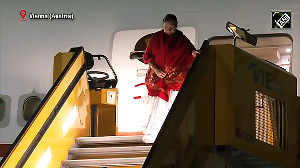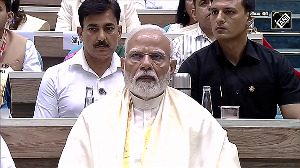The eyeball was still attached to the optic nerve; the pupil, still discernible.
The brain, naturally quite small, lay half spilled out from the crevices of the head.
"Pop the whole eye in your mouth. Suck the brain out," Ma said.
Hesitantly, I did. And that is when, as a child of probably 10, I was initiated into Bangal food first, Bengali food thereafter. I'll come to that later.
Fish brain, unlike the popular goat bheja fry which resembles a scrambled egg, retains its silky, mousse-y, texture and explodes on your tongue. Much like marrow stuck inside a bone shank, the fish brain pokes hesitantly out of the cranium, and you have to gently bang the head on your plate or suck out the brain.
The eyes taste different from the brain.
In my house, whoever got the bit with the brain -- either me or my sister as children -- or my parents when we grew up and mothered them -- didn't get the eyes. Just one brain, and two eyes between four people -- you get the picture.
The eyeball is slightly fleshy and gelatinous and drop-dead yum (the jury is still out on whether the eye tastes better or the brain). The cornea, umm, tastes maybe very fractionally crunchy, and the optic nerve doesn't get on your nerve. Yeah, sorry, but I can't quite describe the taste.
Muri is etymologically derived from muro, which colloquially means head (different from jhal muri which is puffed rice).
Ghonto means mishmash or a medley and can be entirely vegetarian as well.
This Muri Ghonto recipe has its origins in former East Bengal, present-day Bangladesh.
On August 5, India offered to play host to a head of government, whose stay in this country is seemingly indefinite, or at least until an alternative is found -- Sheikh Hasina Wazed, the former prime minister of Bangladesh.
As she faces an uncertain political future (her son says neither she, nor any member of the family, is interested in returning to politics) -- as a guest in a country that gave her refuge when her father, Mujibur Rehman, was assassinated -- the only certainty is that she will miss her food.
Machche bhaate Bangali (fish and rice maketh a Bengali) and in opar Bangla (literally translated: That side of Bengal; formerly East Bengal, now Bangladesh), the fish dance the polka. Hasina is living at an undisclosed location in or around Delhi, and the quality and variety of fish pale in comparison to what you get in West Bengal.
Bangladeshi fish is another ball game altogether.
Perched on the Ganges-Brahmaputra delta, the Padma river has the world's best rohu, katla and ilish.
Bengalis in Kolkata had been mourning the turmoil in Bangladesh -- imports of ilish, essentially at its tastiest during the monsoon months of July-September -- had stopped.
So, Hasina will have to make do with poorer fish on her plate while she is in India.
Pre-Partition, when Bangladesh was part of India, Bengalis from the eastern part of Bengal (now Bangladesh) were called Bangals. Bengalis from what is now West Bengal were called Ghotis.
The mythology behind the names is unclear since ghoti means a small pot or urn, while bangal, according to senior journalist Sunanda K Datta-Ray, comes from the confluence of two words: 'bang' meaning the bunds or mud barriers between rice fields and 'al' meaning rice. That is also where the word Bangali or Bengali comes from.
'Amar Sonar Bangla ami tomai bhalobashi (My Golden Bengal, how much I love thee)', Rabindranath Tagore's love song to Bengal (also Bangladesh's national song), was written to protest then British viceroy Lord Curzon's partition of the Bengal Presidency in 1905.
Bengal was partitioned, with the Muslim-dominated regions in the east as a separate province. They were the Bangals, with a Hindu minority, while the western part of Bengal, with its Hindu majority and Muslim minority, were called the Ghotis.
My forefathers were from the eastern part, but they migrated to Calcutta, a bigger, more populous and richer city then, much before Indian independence.
Bangal food, cuisine, whether Hindu or Muslim, then, was pretty much different from the Ghotis. Back then, marriages between Bangals and Ghotis were uncommon, with each claiming cultural superiority over the other.
Traditions and rituals were also slightly different. For instance, after the glut of Bengal-centric Bollywood movies, the tradition or ritual of a Bengali bride covering her eyes with paan leaves is in fact Ghoti, like it happened at Bipasha Basu's shaadi. Now, of course, Bengali weddings are a carousal of cultural confluences and rituals, including sangeet and mehendi. Blech.
But Muri Ghonto, an acquired taste, remains partitioned. Bangals will use less rice while making it. Ghotis use so much, that you can't even see the fish head pieces and it looks more like a pulao. They even use peas! Ghotis barely fry the head, making it biliously stinky.
Muri Ghonto, if made well, is NOT smelly even though it's the head of a fish. So, for comparison, I find bangda (mackerel) smelly. I don't eat dried fish because the stench makes me heave and retch and regurgitate what I ate even 20 years ago.
This is my mom's Muri Ghonto recipe as I remember it.

Photographs: Swarupa Dutt/Rediff.com
Muri Ghonto or Bengali Fish-Head Curry
Serves: 3-4
Ingredients
For the marination
- Fish head, preferably obtained from 2 kg of katla fish, rohu will also do (please see the note below)
- 1 tbsp salt
- 1 tbsp haldi or turmeric powder

For the curry
- 2 fistfuls raw rice (please see the note below)
- 2 medium-sized potatoes, peeled and diced
- 1 large or 2 medium-sized tomatoes, chopped
- 4-5 tbsp mustard oil
- 2 tbsp ghee for frying the fish head
- 2 dried red chillies
- 2 tej patta or bay leaves
- 3-4 green elaichi or cardamom
- 1-inch piece (or a little larger) dalcheeni or cinnamon
- 3-4 lavang or cloves
- 1 tsp haldi or turmeric powder
- 1 tsp jeera or cumin powder
- 1 tsp red chilly powder
- 1 tsp ginger paste
- 3-4 green chillies, cut the stems off
- ½ litre hot water
- Salt to taste, around ½ tsp
- 1 tsp sugar
- 1 tsp garam masala powder (made by grinding cloves, cinnamon, cardamom and javitri or mace)
- 1 tsp ghee, for serving

Method
- Wash the fish head thoroughly.
Drain the water completely, till it comes out clean, clear and not bloody, with maybe a slight tinge of pink.
Marinate the fish head with the salt and the turmeric for at least 30 minutes. - Wash the rice till the water runs clear.
Soak in a bowl of water for at least 30 minutes or more. - Heat the mustard oil and the ghee in a kadhai or frying pan.
Shallow fry the fish-head, over low heat, until well browned.
Keep flipping, so it cooks well on both sides.
The head should look almost singed or lightly burnt.
Then, using a ladle, gently break the head on the vertical -- it will break very easily if it's fried well.
One fish head would approximately break into 3-4 pieces.
Be careful not to smash it to smithereens.
Once the head is broken, continue to fry the sides that look a little less brown.
Remember, you are shallow frying it and not deep frying it.
Transfer the fish head out of the kadhai into a bowl and keep aside. - Place the same kadhai back on the stove, over low heat.
There should be at least a tbsp of oil left in the kadhai, if not add 1 tbsp oil.
Once hot, add the bay leaves, dry red chillies, whole garam masala and saute till fragrant.
Add the diced potatoes and saute till light brown.
Empty the fried spiced potato onto a plate or bowl and keep aside.
Return the kadhai to the heat and into the same oil, add the soaked rice, after straining out the water.
Be careful as the mixture will splutter.
Saute the rice till it starts popping and changes colour to a really faint beige.
Make sure the rice is not browned.
Add the chopped tomatoes and saute till slightly mushy.
Combine the spice powders and the ginger paste in a little water to make a slurry and add it to the tomatoes.
Stir and cook over low heat.
Once the oil separates, add the fried potatoes, salt, fish head pieces (don't wash the bowl the fish head pieces were kept in yet).
Remember, the fish head has been marinated in salt, so don't load up on the salt.
Add the sugar and the green chillies.
The bowl the fish head was kept in, after shallow frying, will have some oil left from the cooking and fat from the fish head itself.
Add that to the pan -- it ups the taste.
Saute for a minute or so more and add the hot water.
Cover and cook over lowest possible heat for another 10 minutes.
Check if the rice is cooked, if it is, then so are the potatoes and the fish head.
The Muri Ghonto should neither be runny nor dry.
Take off heat and finish it off with a sprinkle of the garam masala powder and the ghee.
Cover the kadhai and let the aromas steep.
Serve hot with steaming hot rice.
Swarupa's Note: For the rice, the best pick is gobindobhog. Ambe mohar will also do. The rice should be fragrant and short-grained, but if you don't have either, use tukda (broken) basmati.
Only katla or rohu head is used in this preparation. The gills should be cut off as they are hugely smelly and best avoided. Ask your fishmonger to cut off the mouth (around an inch) as that's where the teeth are.












 © 2025
© 2025